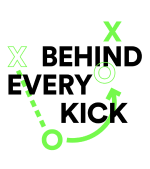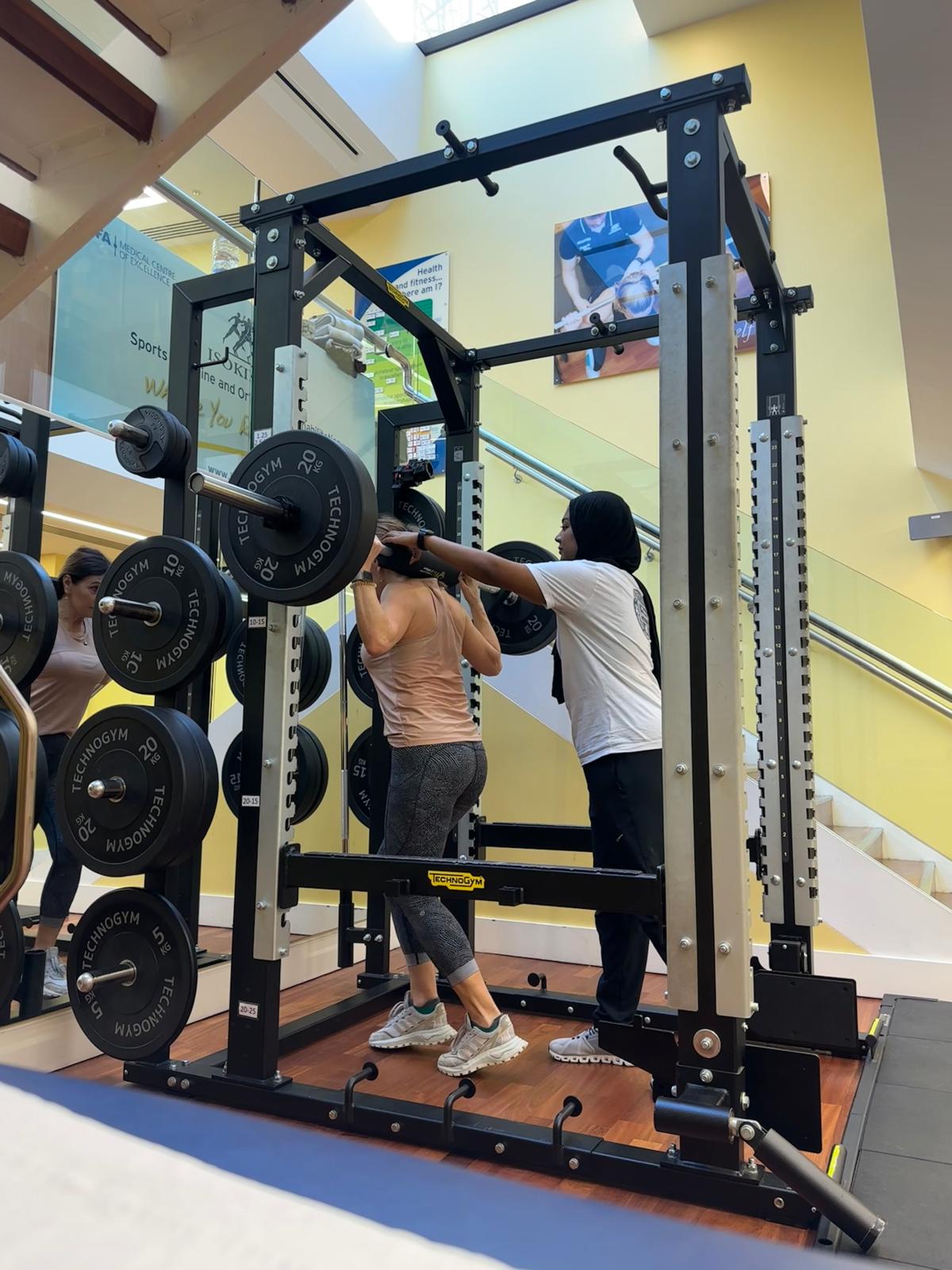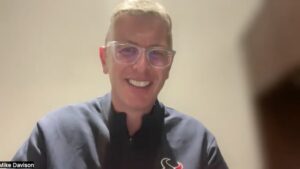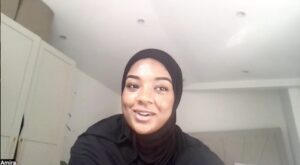It’s 8am in Houston, Texas, from where Mike Davison logs on to our Zoom call, to offer Behind Every Kick’s young people an insight into life at the sharp end of sports science. The bull’s head logo – in Lone Star State colours – on his top is a tell that Mike’s working day has been underway for some time. He’s already attended a Houston Texans team meeting as they gear up for their first game of the season in the NFL’s American Conference. The Texans are one of many elite teams across multiple sports that Mike advises on athlete care and performance. Joining him on today’s panel is Amira Mohamed, who is positively glowing, having just successfully completed her degree in Sport and Exercise Medical Science at UCL.
What is sports science?
‘Sports science is ultimately about giving opportunities to individuals and teams to maximise their potential,’ explains Mike, as the conversation gets rolling. ‘We’re looking to gain a competitive advantage by maxing out an athlete’s abilities and protecting them from underperformance, be it physical or mental.’
‘I’d echo that, ’ says Amira. ‘It’s for anyone who wants to keep active and understand how their body responds to physical activity, both in sport and general health. It encompasses biomechanics, nutrition, and injury prevention. It’s such a broad topic, and the research around it is always growing.’
What drives your passion for sports science, and can you tell us the paths you’ve taken within the field?
‘When I was in secondary school, I always loved sports,’ recalls Amira. ‘But it was difficult for me because the school was small and there weren’t that many girls who wanted to play. I had a cool teacher who helped me set up a lunchtime programme offering opportunities for girls to play sport together. I could see from an early age how sport can build confidence and wellbeing. I gained an insight into the science of how physical activity and exercise affect our bodies at a deep level, including cognition. It showed me how performance and medicine intersect.
I picked my undergrad at 17. There’s a lot of pressure on that decision. You only get five UCAS choices. I knew my passion was for sports, so I did lots of research and career quizzes. I drew up a long list and, eventually, boiled it down to the courses at UCL and King’s because I knew I wanted to stay living at home. UCL has a great reputation for research and is affiliated with the Institute for Sport, Exercise and Health. I thought studying there and having access to the clinicians and labs would give me a different exposure to the industry. Rather than straight sports science, I picked the medical science degree because it bridges health performance and rehab. That appealed to me as I didn’t know at that stage what I wanted to specialise in as a career. It allowed me to keep my options open. I loved the whole university experience. My cohort was quite small, so it was more classes where we sat around a table in groups with the academics and had discussions rather than big lectures. My first year was an introduction to medical sciences, looking at diseases, physiology, and organ function. Year two focused on health & science. We studied health economics, infection, and inflammation. My final year concentrated on sports performance and optimisation: injury rehab, medicine, and how exercise can improve health. I also had to complete my research project, which involved designing an experiment, running it through ethics, and collecting, analysing, and presenting data. I had a guest lecture that made a big impression on me. It was about sports performance analysis – exploring the software being used, and methods of data analysis. The level of precision it requires was fascinating. How to use data to optimise an athlete’s performance is something that really excites me.
In the summer holiday before my final year, I arranged a six-week placement at Isokinetic (a world-leading sports rehab clinic), which gave me hands-on experience of working with patients and seeing the medical staff in action. That’s the next step for me. Trying to expand my network and discover what careers are out there that match my interests. I’m also considering a three-year NHS Master’s programme where you can work and study at the same time.’
‘Mine is a random path,’ reflects Mike. ‘I’ve always had a passion for sport and been interested in healthcare. I’m motivated by doing something that hasn’t been done before and breaking the mould. I studied geography at university, and that gave me a mindset of thinking internationally. I decided to study for an MBA and met an Australian guy who had the misfortune of rupturing his Achilles tendon while playing sport here. This was in 2001, and there was no specialist provision of sport and exercise rehabilitation in the UK. He’d played rugby league professionally in Australia, where there was a proper pathway for sports rehab with quality controls. I think I felt a bit responsible for him being a guest in our country, and I used his experience to write a business plan for my MBA. That ultimately resulted in the creation of a private sports medicine, physiotherapy, and nutrition group, Pure Sports Medicine. I came to understand very quickly that in professional sport, it’s the physios, psychologists, and nutritionists who spend the most time with a player. They have the potential to make the most positive influence on athletes’ performance and well-being. My ‘why’ has always been how to use sport for good – how can you create a health care system that caters to the needs of the pro athlete, but is there also a way of taking those principles and applying them to the wider population?
Being persistent is crucial – that and saying “yes” to things – creates opportunities in this field. That’s how, despite not being medically trained, I’ve ended up here speaking to you this morning from Houston. And even when I say “no”, I always try to give a positive “no” – can I shape it so it can be a “yes” in the future?
How has the sector changed in the last 20 years?
‘There are a couple of things that stand out to me,’ explains Mike. ‘Number one, there is an expectation for people to work in an interdisciplinary way. We talk of the T-shape. Members of the sports science team need a depth of knowledge and specialisation, but they also require a broad range of understanding across all roles in the department. So, for example, you are the physiotherapist, but you understand enough about the language of psychology or nutrition to join the dots. There is a need to work collectively as a team at speed to deliver results and enable players to perform to their potential. It’s a bit like working on a Formula 1 car in that respect. I think that’s why what are commonly called soft skills – effective communication, dealing with pressure, and having the personal integrity required to have courageous conversations – are so vital in the sports science world.
Secondly, there is now a far greater focus on sports science in the media and in the general conversations that go on around sport. There’s a greater literacy in the wider population about this stuff, just look at the explosion in wearables like FitBits and Oura rings. You’re witnessing the beginnings of the commercialisation of performance data. It won’t be too long until you can see the heart rate of the goalkeeper and penalty taker on Sky Sports.
I think COVID caused people to be more introspective and health-focused. We’re generally living longer, but is our quality of life any better? I think there is far more acceptance in the workplace that a performance lifestyle, performance wellbeing is important. People need to find the rhythm that works for them, and employers are starting to understand that. The language around mental health was previously used to express weakness, but now it’s becoming seen as a strength. I remember meeting with an NFL head coach in 2019, where I said, “One of the areas you need to develop is building a mental wellness culture to help individuals perform under pressure on the field and in life.” He scoffed at me and said, “No, no, no, Mike. If they’re mentally weak, then they shouldn’t be here.” Fast forward to today, and I’ve just heard the Houston Texans head coach DeMeco Ryans immediately tell his players, “If you feel something isn’t quite right mentally or physically, declare it. Understand if you declare it to somebody, it’s between you and them, but if you don’t declare it, it’s going to be a problem for the team somewhere down the line.” That’s a huge shift. Creating an environment where people trust each other and can have conversations where they show vulnerability is something I’ve put a lot of effort into. A problem shared is a problem halved, and nowadays, if you’re not open, I think it causes more concern. Answering ‘How are you today?’ with ‘I’m fine’ is a red flag. The answer can be ‘I’m great’ and this is why, or it might be ‘I’m feeling a bit off actually because I had an argument with one of the kids’. Those responses create a point of connection. That’s the same in whatever world you’re in, school, business, or elite sport – you’ve got to treat the human being first.’
Where do you see sports science going in the next 20 years?
‘Data and AI are evolving so quickly,’ Amira asserts without hesitation. ‘In the next 20 years, artificial intelligence will be used to analyse players’ game activity and even predict match outcomes. It will help talent identification. There’s so much it can do, and it will be fascinating to see where it leads.’
‘I’d echo that,’ says Mike. ‘But as ever, it’s about the interface between the human and the machine; the quality of the questions you’re asking and using it efficiently. Certainly, diagnostics will be transformed. The GP won’t disappear, but a lot of the answers lie in patients’ history – if you have access to 10,000 cases rather than ten, there will be big improvements.
There will be variations to examine between age groups, genders, ethnicities, but then also drilling down even further into individuals within those groups. A lot of sports medicine has been a projection, if not an imposition, onto people – a push, whereas I think individuals are going to pull from here on out. They’ll be better educated and take more ownership over their own health. The challenge will be how to make a general principle apply to an individual and how to get an individual to comply behaviorally. So the sports psych/behavioural health area is going to be huge. Things like our routine and sleep – what we call “the other 22 hours” of the day when we’re not out on the field.’
What attributes do those who want to break into the field need?
‘Curiosity is the big one for me,’ explains Amira. ‘That and excellent research skills. Research is at the heart of sports science. It doesn’t just improve performance but also protects athletes and ensures sport is safe, accessible, ethical, and inclusive.’
‘You’ve definitely got to do your homework,’ stresses Mike. ‘A lot of it boils down to knowledge. But also, how do you apply that knowledge? Ultimately, do you engage and empower other people? So, developing your soft skills and the art of persuasion to change behaviours. How do I, Mike, a white man in my 50s from England, connect with a young black man from Baltimore or a World Cup winner from Buenos Aires? Fundamentally, you’ve got to be brave. You’ve got to have that bit of confidence – not cockiness – to step forward in their environment. You don’t go in with a know-it-all attitude; you show the curiosity Amira mentioned. You ask questions, mostly about them, and demonstrate to them that you care. You try and impart a sense of how they might be able to beneficially utilise your skills. You don’t push it – you make them an offer, a commitment. You follow up and you follow their energy. They want to know ultimately that you’re not looking for a piece of them. Often, that’s how elite athletes feel – that they are a commercial entity that everyone is trying to exploit. It’s not about staying in your lane, it’s about having the confidence to believe you belong there and have skills to bring – it’s no good being there and not doing anything. That helps no one.’
Traditionally, sports science has been dominated by older white men. Do you think that is changing?
‘Think about the athlete population,’ implores Mike. ‘I’m not saying you can’t connect across boundaries – there’s always a way to do that – but with that being said, for people from non-white, non-male backgrounds, now is your time. Human connection – getting people to open up about how they’re feeling – is the piece that has been missing. Have confidence that the doors are open and you’ll be in demand. We shouldn’t be complacent, and it’s not about giving people opportunities because they are a woman or person of colour, but there’s a bit of a levelling up happening, and that will benefit everyone. I’m a huge advocate. Ultimately, I think it’s in the best interest of the players that the diversity of the team on the field is reflected in the sports science department.’
‘Now more than ever, change is happening,’ posits Amira. ‘Sometimes you do have worries about breaking through, but it’s important to have a network around you that reinforces that you can do it and have what it takes. Be honest with yourself and give yourself credit when it’sdue for the work you’ve done and how far you’ve come. Like Mike said earlier, be persistent.’
Finally, what do you think about the enhanced games, due to be held in Las Vegas next year?
‘I grew up in an era when it felt like everyone was using drugs in cycling,’ reflects Mike. ‘In a sense, that created a level playing field. But intrinsically, I view it as cheating. The enhanced games are trying to create a freak show. The beauty of sport is that there are relatively few barriers to entry. There is scope to come from anywhere and succeed. But when you create a system that allows access to substances that provide a competitive advantage that outstrips hard work, determination, and talent, for me, it’s a no. Also, because it’s in Las Vegas, it’s a double no!’
’I’m with Mike,’ says Amira. ‘It goes against what sport should be about, sportsmanship and integrity. Also, I have safety concerns. There isn’t that much research on performance-enhancing drugs. Not that many athletes who have used them are willing to speak upor put themselves forward for testing, so we don’t know the long-term effects. I’m not sure how far some of the athletes will go. I can’t get behind it, but it will certainly be a spectacle.’



